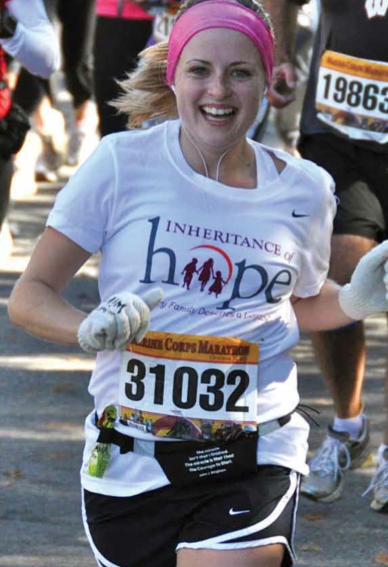For runners who missed out on general registration for the Marine Corps Marathon, the Charity Partners Program offers a chance to enter late and raise money for a good cause.
Marine Corps is unique among marathons because it does not require its participating charities to pay any kind of fees or premiums, meaning all money raised through the charity program running goes directly to the organizations. This year, 4,674 runners will raise money for 101 different 501 (c) (3) organizations, from the longstanding MCM team for Injured Marines Semper Fi Fund to the brand new to MCM Alergy & Asthma Network Mothers of Asthmatics team.
“The partners can really do it however they want,” says MCM Public Relations Coordinator Tami Faram. “We just direct people to our website and they can choose a team, we don’t have any preferences.”
The race is put on by the U.S. Marine Corps, runners race for honor rather than prize money, and satellite races (called MCM Forward) at military bases and on aircraft carriers around the world meant that in 2011 a total of 30,000 runners were able to participate in this momentous marathon event.
Though raising money may seem like a lot of work, Faram explains that new technologies make the process much easier than in the past. “People are not having to pound on doors any more, they can Facebook and email their friends to raise money and spread the word.”
Runners at this year’s MCM will see Charity Partners organizations setting up tents and booths in two locations: teams as small as 25 and as large as 800 will meet on “Charity Hill” at the start near Iwo Jima Memorial, and on “Charity Street” (i.e. Kent Street) in the finish festival in Arlington.
The opportunity to snag a much-coveted entry into this prestigious race, the coaching and support provided by an organized team, and of course the venue to raise money for a good cause, draw many runners into the Charity Partners Program.
“I did my first marathon back in 2009 just because I wanted to do it,” said local runner Perry Rosen. “But I wish I’d done that one for charity because it’s such a strong motivating force to have a cause you believe in in the back of your mind while you’re running.”
Rosen will lead one of the Washington Humane Society teams in their third year of raising money through MCM. He coaches 30 runners who all believe in the WHS cause. The $35,000 raised by his team will fund law enforcement investigations, a justice fund to stop animal cruelty, education in local schools, and WHS’s shelters and foster care program.
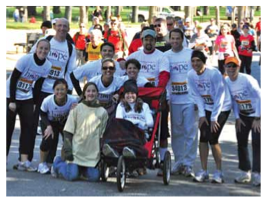
“Our team has a whole range of people, from those who have run 10 plus marathons to novices,” he said. “I jumped at this opportunity be- cause marathons are a daunting task. It can be easy to lose focus, but having the animals as a motivating force and knowing that the money we raise goes directly towards their benefit really helps.”
The Charity Partners Program has proven itself beneficial to runners and MCM alike. Farrah explains that the charities are “really great about disseminating information to their runners and guiding new marathoners through the process.” And like many of the charity runners in this year’s MCM, Rosen’s primary goal is not a personal record (though he’d like to run in the 3:30-45 hour range), but a more selfless goal — to raise money for a cause he cares about and to support his teammates.
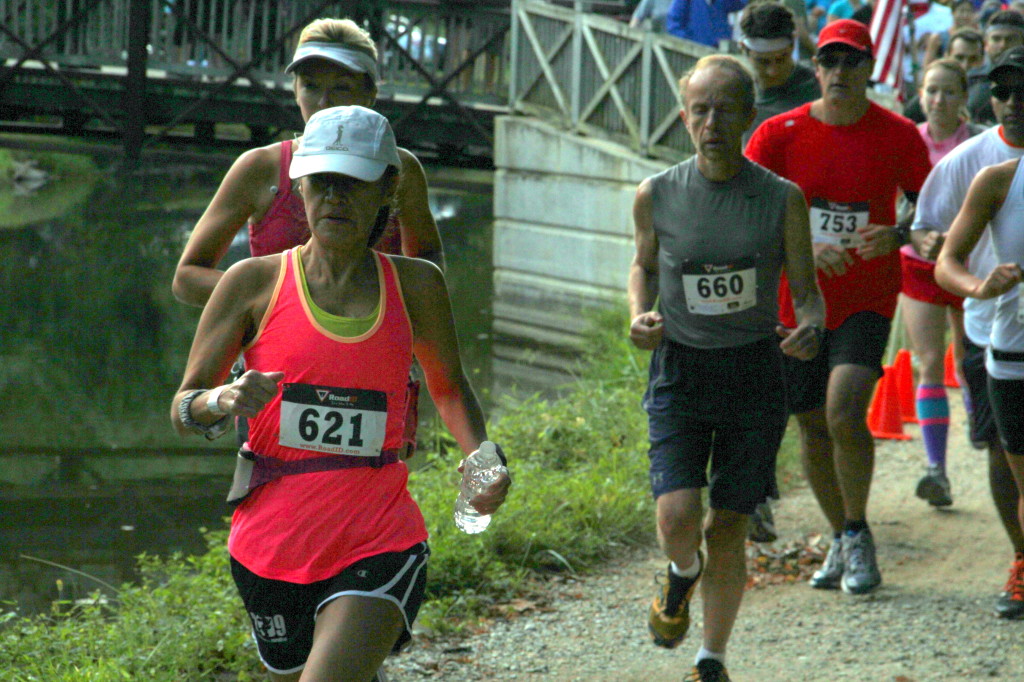
The inaugural Abebe Bikila marathon kicked off at 8 a.m. and 9 a.m. Saturday on a day which could be described as a runner’s dream.
The temperature was in the low 60s at the start and did not crest above 75. This race has run for many years as solely a half-marathon, but this year a 26.2 mile event was added, mainly out of demand for a Saturday race which could be used as last chance Boston qualifier.
The race was held in memory of Abebe Bikila, the Ethiopian runner noted for winning two Olympic marathons while racing barefoot in the 60’s, and then very shortly after being confined to a wheelchair due to a tragic car accident. The race was also held in commemoration of 9/11 with 188 bell tolls being rung at both starts to commemorate the 188 lives lost when a plane crashed into the Pentagon. The daughter of one of Abebe Bikila’s close friends, Selamawit Seifu (daughter of Seifu Makonnen) sang the national anthem before both waves and just by chance a plane flew over each time. The race was small, only about 300 participants, and started at Fletchers boathouse with the course running out and back along the C & O canal (the marathon going out and back twice).
Both champions were relatively new to the sport of distance running, Aaron Misera completing the race 2:44 in only his second marathon attempt , while Tricity Andrew made her marathon debut winning in a time of 3:15 . When talking about his strategy for the race, Aaron who hails from the Pittsburgh suburb of Lower Burrell and is now an AU grad student says he kind of “just goes”. Since he is markedly busy with school, and work, he said of has to fit running in whenever he can and runs mostly by himself leading to a lot of miles spent on the C & O. “I don’t mind this solitariness, though as D.C. is by far my favorite running city,” he said. “Especially on days like Saturday when the canal was delightfully un-smelly!”
Andrew, who hails from Blacksburg, seemed excited about running her next marathon, whenever that may be (a hefty statement , because many marathoners know immediately after finishing the first one).
“I’m naturally better at longer distances, and I get better the longer the race,” she said. She might hold off on increasing the distance any more, for the time being.
Many runners chose this race as a Boston qualifier attempt. Both Michael Selmer and Robert Marino say they picked this race specifically for that reason, motivated by the finish line-area bombings at the race last April. Selmer was so motivated that he ran another marathon two weeks prior, missing his time by a mere five minutes. This caused him to really kick it in the last few miles Saturday to prevent that from happening again, which was evident in both his jubilation and exhaustion as he crossed the finish. Marino was motivated enough by this past April’s events to do his first marathon in two years after an ankle injury, even with the ankle not yet being a hundred percent healed.
Amy Tillman and Pamela Walsh, who run with the D.C. Capital Striders, ran the race together and did also qualified for Boston. Amy thinks that this race will make the rankings for the Top 10 Boston Qualifying marathons next year, a sentiment many other runners in attendance echoed.
Michelle Landry is probably the happiest runner I saw cross the finish line, in colorful apparel from her company smashfestqueen.com for completion of her 11th marathon. She was ecstatic to finish is only 5 minutes off her PR even though she was untrained.
All in all, it seemed from the runners in attendance that they couldn’t have asked more from a race than what was given Saturday, splendid weather, perfect course, and cheerful competitors.
When asked to sum up his thoughts on the race, director Jay Wind left us with the quote, “Everybody needs a mountain to climb, & I’d prefer one that is flat and off road.”
Changes to the Marine Corps Marathon course are exciting local runners and likely going to mean faster times this October.
Runners will not have to endure a big hill around the Georgetown Reservoir between miles seven and eight. Instead, from miles six through nine, runners will run up Rock Creek Parkway to the bottom of Calvert Street and back, a stretch used in the Navy and Nike Women’s half marathons, as the MCM course returns to a pre-2007 design.
Race director Rick Nealis said in a press release that the new course offers “more spacious and flatter roadways.”
“Georgetown,” he added, “especially M Street, remains important to our runners and, annually, the hot spot for spectators and supporters.”
Previously, runners turned left onto Canal Road off of the Key Bridge to Georgetown on the way to the big climb up Reservoir Road into the Palisades, past the Georgetown Reservoir and down McArthur Boulevard and Foxhall Road. On the new course, runners will hit Georgetown’s M Street earlier in the race, in mile five, before they head down to Rock Creek and Potomac Parkway and then around Hains Point.
Another change, though minor, occurs late in the race as runners loop around the National Mall. The marathon will now cover 3rd Street to Constitution Avenue. It previously routed through a parking lot on Pennsylvania Avenue alongside the Capitol reflecting pool.
Public Relations Coordinator Tami Faram said MCM organizers “made an operational decision to make the course both safer and more scenic.” Rock Creek and Potomac Parkway had been a part of the race course from 2001 to 2006.
In 2007, MCM had 20,622 finishers, about three thousand less than in 2012. The growth in participants, Faram said, made the hairpin turn at Canal Road both more difficult and congested.
In one of George Banker‘s binders packed with Marine Corps Marathon results, notes, clippings, and other assorted memorabilia, the race historian has a page of splits from the 1987 race. While the MCM historian can’t recall who gave him these splits, he knows they correspond to Jeff Scuffins‘ course record-setting victory in 2:14:01. (Scuffins went through halfway, according to Bankers’ notes, in 1:06:49. Conditions were actually less than ideal, with a rising race time temperature of 60 degrees.)
Banker, who has run MCM 28 times, was nice enough to dig through this binder recently when we asked him what he thought about flatter course. As Banker recalls, the course when Scuffins set his record, had runners starting on Route 110 in Virginia and heading south in Crystal City up 15th Street. You would end up looping back across the starting line at about 7 miles and take Route 66 over the Key Bridge to Georgetown’s M Street, he explained.
Back then, you hit Mile 20 out on Hains Point; the one real hill was behind the U.S. Capitol on C Street.
“That was definitely a faster course,” he said. “I would say, after that” – as construction and other factors began to require route changes – “they all become a little more difficult.”
Does MCM returning to its pre-2007 design – sending runners out-and-back on Rock Creek and Potomac Parkway – make it a significantly faster course?
Two-time winner and RunWashington contributor Jim Hage told the Washington Post, “Anytime you can knock out some hills it’s a good thing.”
Two local runners aiming to set new personal bests in the marathon agree.
Michael Rohlf, who ran MCM from 2010 (his first marathon) through 2012, said he paid the toll of those early hills later in the race. The hills, he added, also made it tough to settle into a good early rhythm.
In his first attempt to break three hours last fall, Rohlf tired late in the race, he said, and ran 3:12. This fall, in an attempt to achieve his goal, he signed up for the Philadelphia Marathon, which he figured would give him a better shot.
“But now that the MCM course has been changed, and in my opinion improved, I really look forward to running it again – maybe next year,” he said.
Colleen Lerro is entered in her third MCM this year and hopes the course change will give her a better shot at qualifying for the Boston Marathon. She ran her first MCM in 2006, before the course change.
If Lerro does not achieve her goal this year, she will be “much pickier next year” and choose a flatter course.
Regardless of the layout, though, MCM is Lerro’s favorite marathon, and “the course I would love to get my BQ on,” she said.
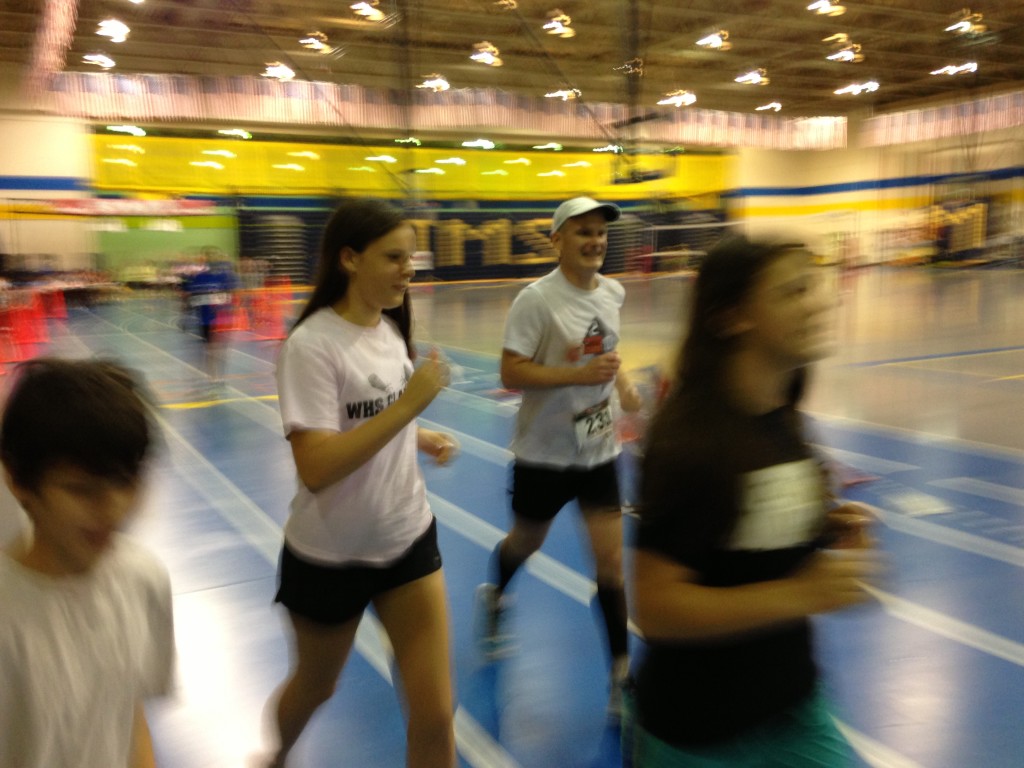
Cathy Ahn has been on the lookout for strange and unique races this year. She found one, a few miles from her Arlington home.
Though she had already signed up for the Grant-Pierce Indoor Marathon, she decided the morning of the race to go for the gusto and run the 50k instead. She ended up finishing second in 4:54:25.
[button-red url=”http://racepacket.com/rsltwrap1.php?id=3836″ target=”_self” position=”left”] Unofficial Results [/button-red]
“I thought about running one more lap than the marathon so it would technically be an ultra, but I decided to just go for it,” she said.
She was accompanied by a handful of Arlington Road Runners, several of whom raced with the rest cheering. Those spectators got to see their athletes a lot. With 210 laps of the 200 meter track for the marathon and 250 for the 50k, the race had almost a dozen lap counters, who tracked several racers to back up the electronic Racepacket timing system.
Eddie Valentine kept his eye on his friend Dave Lin, who was visiting from Manhattan. He was conscripted into the counting corps and limited himself to tracking four runners so he would be able to handle the workload.
“You second guess yourself when the electronic system doesn’t match your count,” he said.
The race started four years ago to give Michael Wardian an opportunity to shoot for the indoor marathon world record and added the 50k to give him an opportunity there, too. The race is named after his two sons. He came through again, running 3:12:13 to Russian Igor Tyazhkorob’s 3:14:49 from 2002.
Wardian tried to run consistent 6:00 pace, hitting 45 seconds for each lap, despite winding through nearly 60 other runners.
“It’s amazing to think it started with 10 people four years ago,” he said. This year’s race had 54 starters.
With wins in several races recently, including the Vermont City Marathon and North Face Endurance Challenge in consecutive weeks, he’s recovered from the stress fractures that plagued his latter part of 2012.
“Just a little pain in my hip today, from the left turns,” he said. “They just started the lap after I split the marathon; It was a little odd.”
Women’s marathon winner Alison Slade, of Odenton, Md. made a pair of comebacks, returning to the marathon after a decade away and racing once again in the Thomas Jefferson Community Center, where she ran many races as a student at the Thomas Jefferson School for Science and Technology. She initially signed up to take a shot at the world record for the women’s indoor marathon, 3:05, but suffered a hamstring injury shortly after than left the goal harder to reach, but she persevered with breaks to massage it and finish in 3:33:21.
The Setash family from Centreville, Va. came to surprise Eric Setash and he went for his age group win to establish a 45-49 indoor 50k national record, which he did in 5:07:35.
“He thought we were home packing for our trip to Cancun,” said his wife, Mary. “We probably should be, but we don’t get to see his ultras.”
His son Charlie and daughters Layne and Abby accompanied him for the last lap. He was ready for his massage, scheduled for Tuesday at their all-inclusive resort, and to demolish every meal that day.
“I’m usually ravenous two days after these races,” he said.
He was disheartened to run over four hours for the marathon en route to the 50k, but he recovered well.
Runners weathered the eight-lap miles in a variety of ways. Lin played head games with the clock, trying to run consistent splits so every few laps, he would cross the starting line at the top of the minute. He didn’t mind the weaving through the lapped runners, because it broke up the monotony of the race.
Steven Waldon on Brooklyn, N.Y. “just zoned out” for about 80 laps. He initially didn’t think he’d have the luxury of doing so, because somehow, at the end of the first lap, he fell down.
“I’ve fallen in trail races, everyone falls in trail races,” he said. “I still don’t know how I fell on a track, on the first lap.”
Making matters worse, he fell again during lap five.
“By my estimation, I was going to probably fall 50 or 60 times,” he said. “I still don’t know how I managed to fall.”
He went on to finish third in 3:54:58.
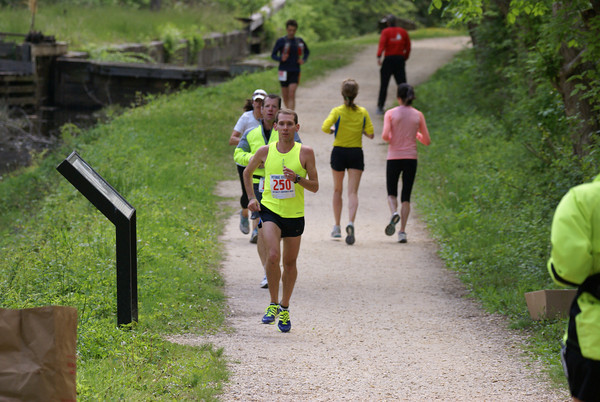
The factors that made Sunday’s race could have been the perfect weather, the flat course on the Chesapeake and Ohio Canal Towpath, or months of hard work and training. Whatever the factors were, the 10th annual Potomac River Run Marathon seemed to have the perfect combination of elements that allowed many participants to qualify for the Boston Marathon and, for many, achieve a new personal record.
[button-red url=”http://youngrunner.smugmug.com/Race-Photo-Galleries/PRR-2013-Marathon-Half/i-vDjDfS6″ target=”_self” position=”left”]Photos[/button-red]Weeks before Strength Running Coach Jason Fitzgerald passed the leader at mile 24.5 at Sunday’s race, he was cheering on two of his athletes in the Boston Marathon at mile 25.5. Afterward, he went to a restaurant in Cambridge, where his phone started to ring. His family and friends had heard what had happened at the race.
[button-red url=”http://www.safetyandhealthfoundation.org/20130505.html” target=”_self” position=”left”] Results [/button-red] “It was a challenging time to be in Boston,” Fitzgerald said. “Even more so if you were a runner and coach.”
Fitzgerald clenched the first-place prize in the Potomac River Run Marathon. His goal in the race was to qualify for the Boston Marathon by 10 minutes. Although he had qualified before, he had never taken advantage of the opportunity. But just moments after making qualifying time, Fitzgerald said he plans to compete in the 2014 Boston Marathon. Fitzgerald said that next year’s race will be that much more special for anyone running.
Albeit a chilly start, temperatures rose to what many runners considered perfect. Along with “Air Quality Awareness Week,” the marathon celebrated “World Laughter Day,” which prompted race director Jay Wind of the Safety And Health Foundation to tell jokes at the starting line.
“There’s nothing quite so funny being out on a race day wearing very little clothing,” Wind said. “We really just try to have fun with it, that’s the bottom line.”
Kirby Mills joined the many athletes who accomplished a qualifying time for the 2014 Boston Marathon and a new personal record. Prior to competing in the race, Mills, who serves in the Marine Corps and is currently stationed at Quantico, missed a Boston qualifying time in March by only 34 seconds.
“I fought to get orders back in Virginia to be close to my family and knock out some races on the east coast,” Mills said. “As I move around in the Marine Corps…I hope to run a Marathon in every section of the United States.”
Mills is a member of the National Marathon Maniacs group, which has a minimum requirement for members to run three marathons every 90 days. The Potomac River Run Marathon marked Mills’ 54th marathon.
“You can’t beat the virtually flat, in-the-shade course, with trees blocking the wind,” Mills said. “It was an easy course with no real tangents to worry about.”
The twice out-and-back course on the sandy—but sometimes rocky—C&O towpath had the potential to be a mental challenge for some. But Chip Warfel and his Mid Maryland Triathlon Club teammates, Heather Beutel and Dan Mooney were not fazed. In fact, Warfel said that he liked the two-time turnaround course.
“Having a turn-around broke up the race,” Warfel said. “It was almost like running a mile—you knew you only had four laps to go.”
At the beginning of the triathlon season, Warfel, Beutel and Mooney all wanted to make the qualifying time for the Boston Marathon—and they did. Warfel said that after the Boston Marathon bombings, he was more motivated to qualify for the race.
“I really want to be there next year to show that no one is going stop anybody from doing this,” Warfel said.
Warfel’s teammate, Deb Taylor, who served as a pacer during the race, will also join her teammates of the Mid Maryland Triathlon club to compete in the 2014 Boston Marathon.
“There’s not a lot of things we can do,” Taylor said. “But as runners, the one thing we can do is show up.”
The Safety And Health Foundation Board of Directors agreed the day after the Boston Marathon bombings to donate $1,000 to the One Fund Boston, an organization that was established to assist the victims of the bombing at the finish line.
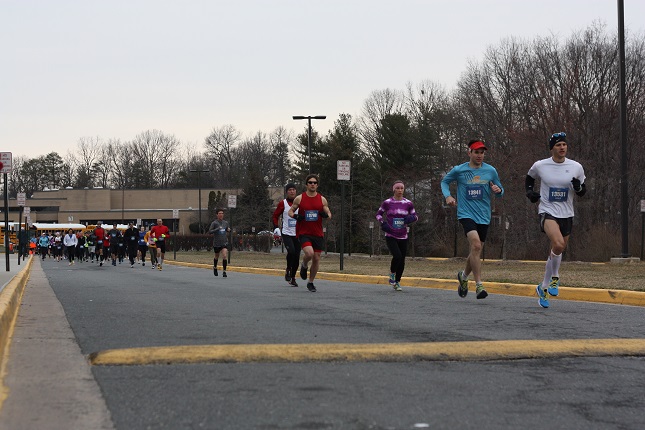
Half marathoners head out of South Lakes High School during the Runners Half Marathon of Reston. Photo: Dorothy Beal
It wasn’t Metro accessible, there weren’t bands every mile and the race might not have had the panache of a national series, but sure enough, a marathon went off Saturday morning in Northern Virginia.
The inaugural Runner’s Marathon of Reston and accompanying half marathon took charge of the streets and trails in a race that billed itself as being “designed by runners, for runners.”
Two sisters, Devin and Alex Nehill, had hatched a plan over Thanksgiving to run their first marathon together. They chose Reston because of the proximity to their hometown and ease of pre and post-race logistics. At the time, they had no goals other than to finish.
As Devin, 17, a senior at Bishop O’Connell, entered the home stretch around the South Lakes High School track, passing half marathoners still finishing, tears were streaming down her face. She took the female win and finished in an impressive 3:09:49, amidst cheers from her entire lacrosse team.
Wearing a shirt that said “The faster you run. The faster you are done,” she had a hard time putting into words how she felt as tears still streamed down her face from the shock and joy of the win.
Though Devin is an amazing runner, lacrosse is her best sport. She was a first-team WCAC and Division I all-state lacrosse player and an honorable mention All-American, as chosen by U.S. Lacrosse, she will be attending Division I Drexel University to lacrosse.
While Devil was roaring down the home stretch, her sister Alex, 19 and a student at Virginia Tech, was still on course. Winning your first marathon is nothing short of amazing. Devin however didn’t bask in her accomplishment, she quickly ran back on course to cheer on her sister.
Local masters runner DeeDee Loughran, 54, took 2nd in 3:15:14. Alex Nihill rounded out the top three females with a time of 3:43:21.
On the men’s side of the marathon, 20-year-old Lee Kaufman clinched the win with a 2:52. Second place in 2:59, was 48-year-old Ian Clements. Clements, a veteran of 14 marathons, described the course as “extremely challenging.” He knew it was hilly but felt it was much harder than expected. His goal was to run around a 2:57 but early in the race knew that was not going to be possible on this course.
“There are trails and there are “trails,” he said, “The C & O Canal is flat and straight. The W & OD is straight and relatively flat. The trails in Reston aren’t straight, and they aren’t flat. It really takes a lot out of you as a runner.”
He had planned to run the Rock ‘n’ Roll USA Marathon but when a work tripped forced his to make other plans, the Alexandria resident said the Reston race was a no-brainer.
The half marathoners took off 30 minutes after the start marathon, and ran the same loop the marathoners did twice. Nate Spong, of Reston, took the win on the men’s side with a time of 1:24:03. Close behind him was Mike Honicker of Sterling, in 1:24: 55. Honicker and Spong are both prepping for triathlon seasons. Both felt the race logistics wise was well run, but did note that there were a lot of false flats and the course was extremely hilly.
Spong sung praises of the new race. “Well marked, the volunteers were awesome, Reston really needed a good half marathon and full marathon and Reston Runner’s delivered on that.”
On the women’s side, Kristen Herring took first in 1:32:08. Reston resident Sharon Adams, who eight days ago became the mother of an adopted 8-year-old from Haiti, took second with a time of 1:35:21. Adams said the race was very special for her. Having her third child there cheering her, screaming “go mommy go” was the icing on the cake to a fun race morning in her home town. Robin Witlin rounded out the top three women with a time of 1:35:48, finishing on her former high school track.
The Reston Runners decided last year to start a half marathon and marathon in Reston, to complement its variety of road races and triathlons. Dennis Hayes, Reston Runners club president and co-race director of the race, boasted of the tremendous community support the race not only had in the planning stages but also on race day. “Reston has needed a full marathon and a half marathon for a number of years and we are excited to make this a reality today.”
Hayes and his team of six co-race directors put together the race with runners in mind. “We wanted a race where we took the good parts of races we have run and improved upon issues we have encountered at other larger marathons.” Free pasta dinner the night before, morning packet pick up, and a buffet of post-race food that included pizza, buffalo wings, corn bread, oranges, bagels muffins and more, were a few of the perks of this low key long distance race.
The club chose the March date, so as not to compete with other large fall marathons, and to ensure relatively cool weather for participants.
Volunteers were plentiful at the race, making everything run smooth for participants. Mary Mullaney of Reston believes as a runner and triathlete it’s important to give back. “Volunteers make these races happen, and I participate in many throughout the year, so I also volunteer my time on the ones I’m not racing.” Aprille Sherman of Sterling, a member of Reston Runners, was really excited to be volunteering. The spirit here today is infectious; it makes you want to sign up to run another race. Sherman who is training for the Cherry Blossom 10 Miler also felt that it’s important for runners to not just participate but to also give back to the sport they love.
Post-race, runner’s enjoyed the plentiful food in the South Lakes Cafeteria, staying warm while sharing their stories of what may become a favorite race of many.
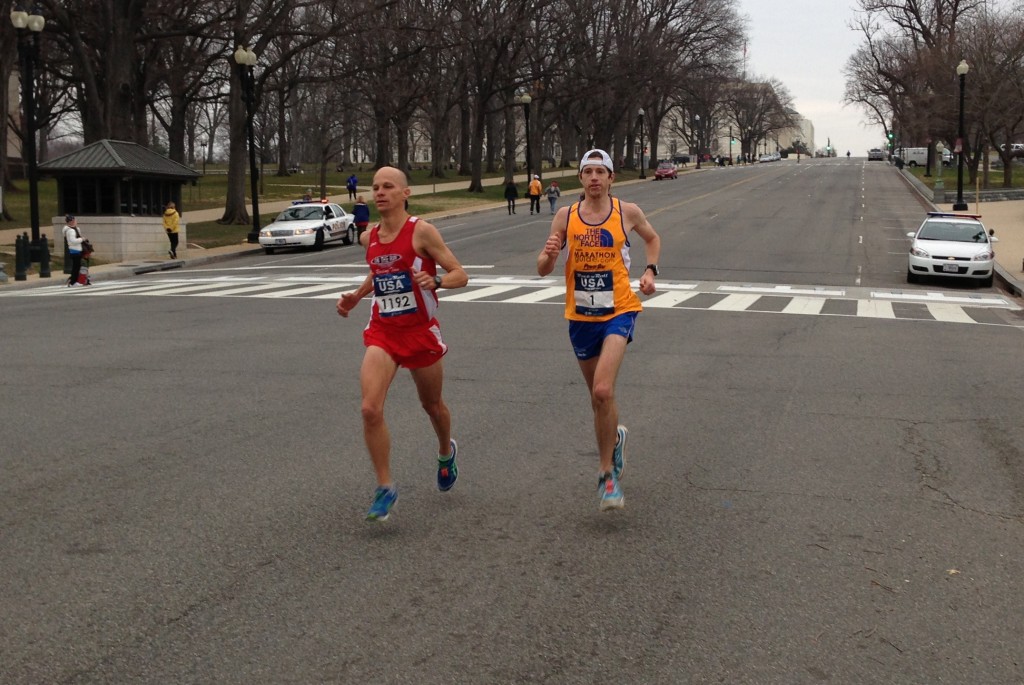
For the seventh year in a row, Washington, D.C.’s spring marathon champion was a college athlete who competed for something other than a track team. For the first time, though, it wasn’t former lacrosse player Michael Wardian.
[button-red url=”http://running.competitor.com/cgiresults?eId=54″ target=”_self” position=”left”] Results [/button-red]Peter Lawrence came to Washington with his family for a spring break trip requested by his daughter.After 20 hours of driving, with stops in New Orleans, Atlanta, the now-41-year-old, who played tennis at the Virginia Military Institute hit town for a week of sightseeing with a cadre of elementary school-age children.
[button-red url=”https://www.facebook.com/media/set/?set=a.628521877175048.1073741833.189448104415763&type=1″ target=”_self” position=”left”] Photo [/button-red]
It just so happened that the Rock ‘n’ Roll Marathon was taking place while he was in town.
“I needed another marathon,” he said. “I did Houston two months ago and it was time for another one.”
He spent most of the race running alongside Wardian, of Arlington, who spent more than six months dealing with multiple stress fractures that disrupted his prolific long-distance racing schedule.
“I figured Michael knew the course, so he was the right guy to run with,” Lawrence said.
Apparently not, because course revisions in Southwest Washington and a confused bicycle guide led the duo astray in mile 16, adding approximately 30 seconds to their times. Wardian’s experience ended up serving neither of them, and for a while it seemed it only enlarged their gap behind frontrunner Jordan McDougal, who held more than a two-minute margin at 18 miles.
“It hurt my PR a little bit,” Lawrence said, noting his 2:32:27 today was almost 2:30 better than his Houston Marathon finish Jan. 13, itself a dramatic improvement over the same race last year, when he ran 2:42:09.
McDougal’s lead shrunk in mile 19 after his stomach got the better of him and he called it a day, not bad work for a guy who decided less than a week ago to give the race a shot. By then, Lawrence had broken away from Wardian and was on his way to checking off “win a marathon” on his bucket list.
“Once I saw I was in the lead, I just kept going and going, tightening the screws a little bit,” he said. “By 25 I felt pretty comfortable.”
He got a boost seeing his wife, son, daughter, niece and nephew in mile 18, where things started to happen for him and he saw himself realize a dream he didn’t imagine having a few years ago. He wouldn’t quite get the sub-2:30 he wanted, but he’s not complaining.
“I started as a middle-of-the-packer,” he said about his introduction to marathon running at age 39. “I got better with more miles and some track speed work. I never realized how much that helped.”
In Houston, Lawrence trains with the Bay Area Running Club. He’ll be back there less than two days after breaking the tape at RFK Stadium.
Meanwhile, Wardian didn’t seem to mind trailing by almost two minutes. For his fourth run longer than 14 miles since he started running again in late January, he was surprised to have run so fast. Though he won the Lower Potomac River Marathon six days before in 2:42:31, it was not without its complications.
“I had to stop in the middle,” he said. “My bladder’s not used to holding so much fluid. Luckily I got by without a stop today.”
He’s running about a third of his normal mileage, but after staring into a huge chunk of his calendar unable to run at all, just being out there is a gift.
“I was unbelievably pumped,” he said. “I started out just happy to be in the top 10, but then you get to the point where you realize you have a shot at the podium and you get a little greedy.”
Third place finisher Eric Senseman, of Madison, Wisc. didn’t mind feeling greedy as he moved his way through the top six when the half marathoners peeled off. He was racing in Washington for the first time, though he’ll be returning in June for the North Face Endurance Challenge.
“I felt like they shut down the whole city for me,” he said. “It was a cool way to see D.C.”
The men’s half marathon came down to a dramatic move made on the hill leading off of the Rock Creek Parkway to Calvert Street. Ethiopian Tumicha Horsa put a move on Falls Church’s Chris Mills that Mills couldn’t cover.
“We were moving along at a little under five-minute pace and all of a sudden there was a giant hill,” Mills said. “He got me by about 15 seconds, but after that I didn’t get any closer and he didn’t get any farther ahead until the last mile. My coach thought I could catch him, but he had a kick.”
Horsa, through an interpreter, said he wasn’t familiar with the course, so he gauged his move on how the race was going with Mills and when he saw the hill, he took his shot.
“When I got to mile 12, I pushed,” he said, via the interpreter.
Horsa ended up in 1:06:44, with Mills behind in 1:07:03 and George Mason University alumnus John Holt in third in 1:08:20.
Winds up to 30 miles per hour, snow flurries in 30 degrees, rolling hills and plenty of warm chili — it’s all in preparation for springtime races and a long-time tradition for the DC Road Runners Club. At the 52nd annual Washington’s Birthday Marathon and Relay, the club brought in more than 500 runners to race on some of Greenbelt’s most challenging roads in an effort to get the athletes primed for the season ahead.
“You don’t get the intensity if you train on your own that you do in a race,” said overall marathon winner Miles Aitken, 29, of Washington D.C.
Aitken, who won with a time of 3:08:43, said he planned to come back next year. “It was a great course and well organized,” he said. Though his specialty race is 5K, Aitken was using the DCRRC GW Marathon to train for the Rock ‘n’ Roll Marathon USA in March.
Aitken wasn’t alone. Many runners who braved the gusts of wind and rolling hills were getting ramped up for springtime races.
Not all runners had to complete the entire 26.2 miles to lace up their racing shoes. In addition to the full marathon competition, the DCRRC also hosted a relay for runners who wanted to race a shorter distance. With more than 100 relay teams, Ben Richter, vice president of races for the DCRRC, said the relay teams made-up roughly half of the race participants. Richter said the relays tend to get more people involved.
Emily Buzzell, 27 of Washington, was the first of three runners to compete in the co-ed “Team Dojo” squad. Her team finished first in the co-ed relay series with a time of 2:52:20. Buzzell said the relay gave her something to run for.
“I turned a corner after the fifth mile mark and ran into a 30-mile-per-hour wind,” Buzzell said. “I was exhausted and everything hurt but didn’t want to slow down because my team was counting on me.”
Buzzell’s other motivating factor to race in mid-February is the Boston Marathon. “Everything’s geared toward Boston,” she said.
“Relays are good activities to help you be accountable for other bigger goals,” said Buzzell’s teammate, Kit Wells, 36 of Damascus, Md.
In addition to appreciating the atmosphere of teamwork, Wells enjoyed the course, which passed a federal agricultural research facility. One of the Greenbelt country streets was even named “Poultry Road.”
“It’s the closest thing I’ve come to experiencing anything dealing with poultry research,” Wells said. “It’s nice that the same footprint can be used for healthful recreational. That’s a good mix,” Wells said.
Among other relay teams and running clubs competing throughout the race, the American Hispanic Running Club had a strong showing in support at the finish. When talking about their favorite part of the course, many of the club’s runners said the finish. The club, which is trying to bring more Hispanic members to the running community, took first in the Masters Male Relay team with a time of 3:15:35. The group is preparing for the Rock ‘n’ Roll USA Marathon in March and the Parks Half Marathon in September.
For Jane Lanford, 47 of Fairbanks, Alaska, the course was a refreshing way to experience the east coast.
“I have this impression of the east coast as entirely built up,” Lanford said as she tried to warm her hands—even after she had been inside for an hour. “It was very nice to be out in the country. I really enjoyed that.”
Lanford traveled all the way from Fairbanks, Alaska, where she trains outside all year long. She finished first in the woman’s masters at 3:54:04 and hit her goal: to break four hours. The Washington’s Birthday Marathon marked the 15th race in which Lanford broke four hours. This is part of her goal to run 50 marathons in less than four hours.
“I’m not getting any younger so I might as well do them now the best I can,” Lanford said.
Amanda An, 25 of Ellicott City, touted her Howard County roots and said she liked the hills.
“I actually like them better than the flat courses,” An said. An was the first female finisher with a time of 3:35:02. She got her start in 2008 when she ran her first marathon. The race marked An’s 17th marathon.
“Once you get mixed up in the running community and get talking to other runners and their achievements—then you start questioning your own abilities and what you can give,” An said. “It really motivates you to try to push your own limits.”
An ran the marathon in preparation for her second 100-miler, the Boston Marathon and brought her one step closer to reaching her goal of completing at least 50 races a year—part of the 50-plus group.
It seemed that most runners had used the Washington Marathon as a training ground for their big up-and-coming race, but it was also clear this race was just as important as the big ones. Whether it was one more race closer to the 50 mark or another race allowing teammates to grow stronger, the Washington’s Birthday Marathon allowed many runners to get back in the groove of racing and dust off their racing flats.


